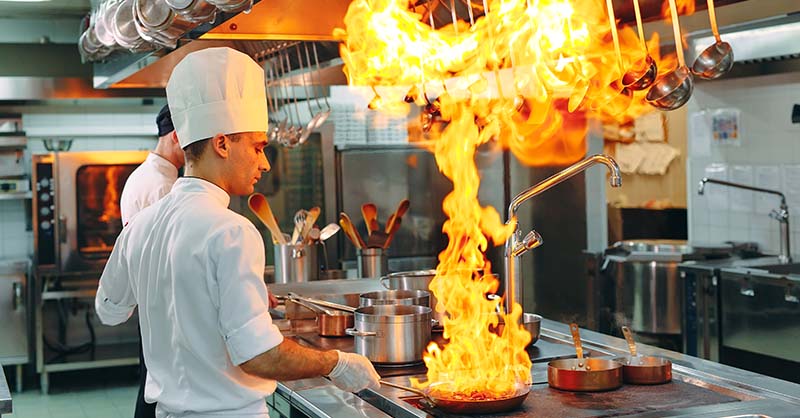Stay Safe While Cooking

Commercial cooking can pose significant risks, which can cause fires that could burn entire buildings. According to the American Burn Association, open flame burns and scalds account for more than 70% of all burns that people experience.
Organizations should take proper steps to ensure that their commercial kitchens are being maintained and cleaned on a basis that is consistent with usage. This should be done with adequate ventilation, clearance and cleaning procedures.
Deep Fryers
Deep fryers are one of the most common cooking appliances, and they can be found in many commercial kitchens. While deep fryers prepare many different foods, they do pose unique risks. Below are some important notes regarding the usage of deep fryers:
- The areas around deep fryers must be cleaned daily or multiple times a day when used extensively.
- Most deep fryers heat up to between 350 and 375 degrees Fahrenheit. The hot oil can cause burns to skin.
- Frying oil should be drained and replaced once the oil begins to darken and become foamy. The frequency of oil replacement will vary depending on how the fryer is used, and heavy usage will result in more frequent replacements. Refilling can be done with an automatic system that drains and refills the oil or by manually draining and replacing the oil. Be sure to consult the manufacturer’s instructions before replacing the oil.
- When a temperature controller malfunctions, the temperature of the fat can readily increase to the self-ignition point, meaning the vapors could readily catch fire. Ensure that an automated shutoff system has been installed and is tied to the temperature sensor of the fryer. There should also be a means to manually shut off the fuel/electricity to the fryer if automatic shutoff fails.
- Deep frying systems should have overhead automatic fire suppression equipment that meets National Fire Protection Association (NFPA) 17A (Standard for Wet Chemical Extinguishing Systems) and 96 (Standard for Ventilation Control and Fire Protection of Commercial Cooking Operations). Equipment listed with Underwriters’ Laboratories should be installed as well. Be sure to inspect commercial cooking fire protection systems regularly to ensure that they comply with state and local fire prevention ordinances.
- Baffles of at least 8 inches should be installed on each side of the deep fryer to prevent oil from splashing onto other cooking equipment. If baffles are not installed, a minimum of 16 inches (40.6 centimeters) of space between the fryer and adjacent cooking equipment is acceptable.
- If water is applied improperly to a fire in a deep fat fryer, boil over can occur, which can result in serious injury to personnel and can spread the fire outside the hood area. Water should not be used when attempting to extinguish a grease fire.
- Ensure that only a Class K fire extinguisher (made to combat cooking oil fires) is placed within a minimum of 10 feet from deep-frying equipment.
- Clean the deep fryer daily. Do not allow for dust or grease buildup that can cause a fire.
New technology allows for cooking equipment to be connected to the apps or devices that have automatic shutoffs as well as cooking monitoring. Be sure to consult with appliance suppliers to see what is available for commercial use and can be installed for your organization.
Overhead Ventilation Hoods
Exhaust duct clearance to combustible building members is critical when cooking with grease-laden vapors. The NFPA 96 standard requires exhaust hoods to have a clearance of at least 18 inches from all combustible building materials. Consult NFPA 96 when using protected combustible building materials as the clearance standards may change based on materials being used. Overhead hood exhaust ducts should lead directly to the exterior of the building and should not be connected to other exhaust systems. Be sure to clean these exhaust hoods and systems regularly as part of the maintenance schedule. This can be done by staff or professional cleaners. Consult the manufacturer to determine what cleaning materials should be used.
Be sure to consult with local or state guidelines as they may have required cleaning schedules for exhaust hoods.
| Types of Cooking and Frequency of Hood Cleaning | ||
| Solid fuel cooking such as wood or charcoal, fast-Food restaurants, 24-hour restaurants | Monthly | |
| Restaurants, cafeterias, moderate-use facilities | Quarterly | |
| Oven hoods, infrequently used cooking areas | Semi-Annually | |
| Appliances that do not use grease | Annually | |
Building materials and commercial cooking equipment should be installed following the manufacturer’s instructions with UL listed equipment when applicable. Consult NFPA standards and complete this checklist for best practices to ensure fire safety.
Resources
- American Burn Association | National Burn Repository 2019 Update
- National Fire Protection Association | 17A Standard for Wet Chemical Extinguishing Systems
- National Fire Protection Association | 96 Standard for Ventilation Control and Fire Protection of Commercial Cooking Operations









